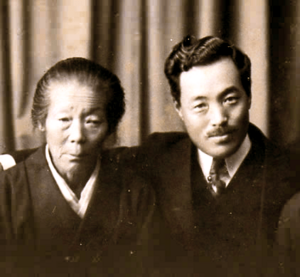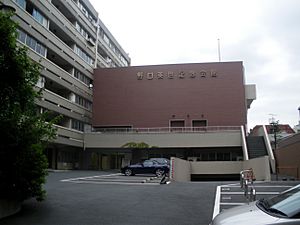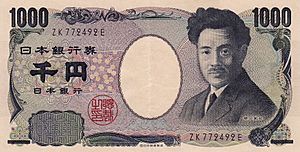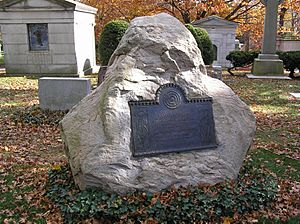Hideyo Noguchi facts for kids
Quick facts for kids
Hideyo Noguchi
|
|||||
|---|---|---|---|---|---|

Hideyo Noguchi with signature
|
|||||
| Born | November 9, 1876 Inawashiro, Fukushima, Japan
|
||||
| Died | May 21, 1928 (aged 51) |
||||
| Resting place | Woodlawn Cemetery, New York City, US | ||||
| Scientific career | |||||
| Fields | bacteriology | ||||
| Japanese name | |||||
| Kanji | 野口 英世 | ||||
| Hiragana | のぐち ひでよ | ||||
|
|||||
Hideyo Noguchi (born November 9, 1876 – died May 21, 1928) was a famous Japanese scientist who studied tiny living things called bacteria. He was also known by his childhood name, Seisaku Noguchi. He spent his life researching diseases and trying to find ways to help people.
Contents
Early Life and His Dream
Hideyo Noguchi was born in 1876 in a small farming village in Inawashiro, Japan. When he was just one year old, he had a terrible accident. He fell into a fireplace and badly burned his left hand. There were no doctors nearby, and his hand was severely damaged.
In 1883, Hideyo started elementary school. His teacher and friends helped raise money so he could have surgery on his injured hand. The operation helped him get back about 70% of the movement in his hand. This experience made a big impact on him. Hideyo decided he wanted to become a doctor to help others who were sick or injured.
He became a student of Dr. Kanae Watanabe, the same doctor who had operated on his hand. He later went to a medical school called Saisei Gakusha. In 1897, when he was 20 years old, he passed the exams to become a doctor. He was very smart and received support from Dr. Morinosuke Chiwaki for his studies. In 1898, he changed his first name to Hideyo. He did this after reading a book where a smart student named Seisaku (his old name) became lazy and ruined his life. Noguchi wanted to make sure he stayed focused and successful.
Research and Discoveries
In 1900, Noguchi traveled to the United States to work as a research assistant. He joined Dr. Simon Flexner at the University of Pennsylvania and later at the Rockefeller Institute of Medical Research. He really enjoyed this new environment. At first, he studied venomous snakes. He moved to the U.S. partly because it was hard for him to get a medical job in Japan. Some employers worried that his hand injury might make patients uncomfortable. But in research, his hand was not a problem.
Noguchi's work was noticed by the Nobel Prize committee. He was nominated several times for the Nobel Prize in Physiology or Medicine in the 1910s and 1920s. He was also chosen as a member of the American Philosophical Society in 1921.
In 1918, Noguchi traveled to Central and South America. He worked with the International Health Board to research diseases like yellow fever, Oroya fever, poliomyelitis, and trachoma. He tried to create a vaccine for yellow fever. He believed that yellow fever was caused by a type of bacteria called spirochaete. He spent many years trying to prove this idea. However, other scientists later found that yellow fever was caused by a virus, not bacteria. It turned out he had confused yellow fever with another disease called leptospirosis. The vaccine he made actually helped treat leptospirosis.
Later Life and Passing
In 1927, another scientist, Adrian Stokes, died from yellow fever. This made it even clearer that yellow fever was caused by a virus, not the bacteria Noguchi thought it was. Feeling his reputation was at risk, Noguchi went to Lagos, Africa, to do more research. He then moved to Accra, in what was then called the Gold Coast (now Ghana), to continue his work.
Noguchi worked mostly at night and kept his research secret from other scientists. He was very focused on his work, but his methods were sometimes messy. He gave many monkeys yellow fever but didn't keep good records. He might have thought he was safe from yellow fever because he had used his own vaccine on himself.
In May 1928, Noguchi was planning to return to New York. But he became ill in Lagos. He was taken to a hospital in Accra with yellow fever. He passed away on May 21, 1928. Just seven days later, Dr. William Alexander Young, who had invited Noguchi to Accra, also died of yellow fever.
His Legacy
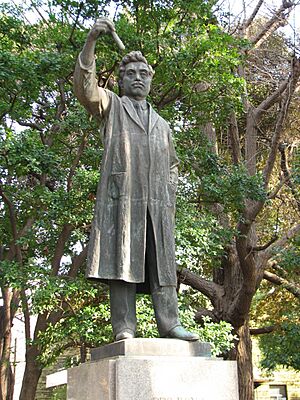
Even though Noguchi was famous during his life, later research showed that many of his claims were not correct. For example, he thought he had found the causes of polio, rabies, trachoma, and yellow fever, but these findings were later proven wrong. His methods for growing bacteria sometimes led to contamination, which made his results inaccurate. Some scientists believed he was unwilling to admit when his claims were false. His failures are often linked to him working alone, without other scientists checking his work.
Honors and Recognition
Noguchi received many awards and honors from Japan and other countries during his lifetime. He also received special degrees from many universities. He was humble in public, sometimes calling himself "funny Noguchi." But those who knew him well said he loved getting awards.
Here are some of the honors he received:
- Doctor of Medicine from Kyoto Imperial University, Japan (1909)
- Knight of the Order of Dannebrog, Denmark (1913)
- Commander of the Order of Isabella the Catholic, Spain (1913)
- Commander of the Order of the Polar Star, Sweden (1914)
- Doctor of Science from Tokyo Imperial University, Japan (1914)
- Order of the Rising Sun, Gold Rays with Rosette, Japan (1915)
- Imperial Award, Japan (1915)
- Honorary degrees from universities in Ecuador, Peru, Mexico, and Yale University, United States (1919-1921)
- Knight of the Legion of Honour of France (1924)
After His Death
Noguchi's body was brought back to the United States and buried in Woodlawn Cemetery in New York City.
In 1928, the Japanese government gave him another high honor, the Order of the Rising Sun, Gold and Silver Star. In 1979, the Noguchi Memorial Institute for Medical Research (NMIMR) was built in Ghana with money from the Japanese government. This institute helps fight diseases in Africa.
Since 2004, Dr. Noguchi's picture has been on the Japanese 1000-yen banknotes. His childhood home in Inawashiro is now a museum about his life. There is also a research center in Mexico named after him. A street in Guayaquil, Ecuador, is also named after Dr. Hideyo Noguchi.
Hideyo Noguchi Africa Prize
In 2006, the Japanese Government created the Hideyo Noguchi Africa Prize. This award honors people who have done amazing work fighting infectious diseases in Africa or creating new medical services there. The prize is given out every five years. It was created to remember Dr. Noguchi's work and his connection to Africa.
See also
 In Spanish: Hideyo Noguchi para niños
In Spanish: Hideyo Noguchi para niños
- List of medicine awards
- Max Theiler - developed a successful yellow fever vaccine
- Human experimentation in the United States


